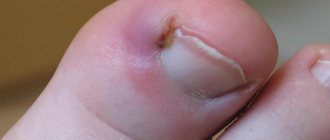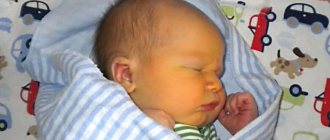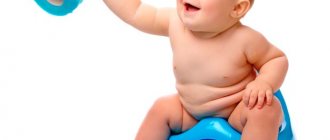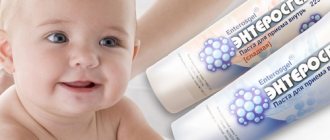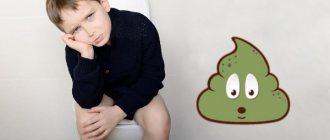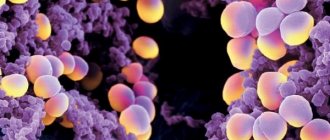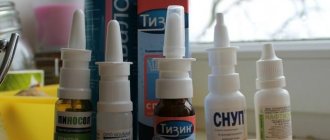Children, like adults, can have ingrown nail plates. The phenomenon is observed even in children who have not yet begun to walk. An ingrown toenail in a newborn causes discomfort and pain; it is necessary to find out the causes and provide timely assistance to avoid complications.
Reasons for the development of the disease
The reasons can be either external, depending on the parents’ poor hygiene of the child, or internal. As mentioned earlier, the disease can be congenital. In this case, heredity is usually blamed if in some family members the nail plate grows downward, damaging the skin. Typically, such an anomaly is characterized by symmetry, when the nail grows into the skin on both sides.
The problem may also be associated with the pathology of the baby's metabolic processes. In addition, a bacterial infection or a lack of vitamins can be a provoking factor.
Sometimes ingrown toenails in young children occur due to improperly selected shoes. It sounds strange, but some parents even put shoes on babies, which constrain the legs, squeeze the toes, and cause the nails to stick into the material of the elastic booties. In babies, the nail plate is very soft, it quickly gives in to any mechanical stress, so even too tight socks can deform it.
The disease is often caused by improper trimming of nails. When the procedure occurs too often, the nails may begin to grow ingrown. It is also not recommended to cut them too short. Sometimes parents are unable to trim their baby’s nails carefully due to his restlessness and restlessness. As a result, an uneven cut is formed, sharp tips lead to mechanical irritation, and subsequently to possible ingrowth of the plate into the skin. Therefore, a nail file in a children's manicure set is a must-have attribute. It is characterized by a soft abrasive, so its use can minimize trauma.
An ingrown toenail in a baby often occurs due to parents' attempts to give it a rounded shape. At the same time, they cut off the corners of the nails, while it is considered correct to leave a straight line.
Causes
Ingrown nail plates can be caused by the following factors:
- Congenital developmental pathology. More often it is caused by heredity and is expressed in the direction of nail growth - not forward, but downward, resting against the skin ridge. In case of a developmental defect, the edges of the plate grow evenly on both sides;
- Nail diseases caused by metabolic disorders, lack of vitamins, infection, etc.;
- Tight shoes that squeeze the toes can cause ingrowths if worn regularly, even if the baby is not yet walking. The nail plate of infants is quite soft, easily susceptible to impact and deformed;
- Incorrect, untimely or frequent cutting of nails. If you cut them too short, the plate rests on the skin roll. The reason may be uneven cutting of the nails, the sharp edges of which begin to grow in. It is necessary to cut them off or sharpen them with a special children's file with a soft abrasive layer;
- Injury to the nail when cutting, due to bruise;
- The most common cause of ingrown toes, on the big toe, is often caused by cutting off the corners instead of leaving a straight line.
Stages of pathology development
It is clear that the baby will not be able to tell where and how it hurts. He expresses his emotions by crying. Therefore, the only signal that a baby has an ingrown toenail can be his restlessness and twisting of his legs (handles). Therefore, if up to a certain point everything was in order, and then the child began to show anxiety, then it is worth carefully examining the baby’s body to detect a problem.
If an ingrown toenail in a baby was caused by hereditary causes, then the problem is discovered in the maternity hospital, when the doctor examines the baby. It is noteworthy that the pathology can be of varying degrees of complexity. Depending on this, the specialist prescribes specific treatment measures aimed at restoring the health of the plate. If the disease is ignored, it begins to progress. However, symptoms may appear in stages.
- Initially, a slight swelling of the lateral ridges appears. When pressing on them, the pain intensifies, which can be understood by the sharp cry of the child: when a doctor or parents try to examine a leg or arm, the baby instinctively pulls back the limb and cries.
- In the absence of therapeutic effects, the roller noticeably turns red. The tumor becomes pronounced, and pus may even appear. Again: if you try to put pressure on your finger, the baby starts crying a lot. It is worth considering that the child is constantly bothered by aching pain, so he is capricious and behaves restlessly even without touching the source of pain.
- At the last stage of development of the pathology, without medical intervention, severe inflammation of the soft tissues and their decomposition occurs.
Surgical intervention
Positive features:
- removing an ingrown toenail with particular speed and decisiveness;
Negative features:
- an excessively long, especially painful period after the operation, which the baby will not be able to endure without much pain and labor;
- healing of injuries and wounds takes a very long time;
- the nail plate is subject to deformation;
- This operation does not guarantee that ingrown nails will not occur again.
Symptoms and manifestations
It is easier for parents to detect an ingrown nail in a baby on their hands. On the lower extremities, the problem becomes obvious when the skin becomes inflamed. It is sometimes difficult for parents to understand what exactly is happening to their beloved child. The baby cannot say what hurts. He just cries and is capricious. But observant parents notice that anxiety increases when a sore finger is touched. Also, some children try to reach the problem area, remove the sock, or, conversely, try to move the foot away. If this behavior is observed, it is important to immediately inspect all fingers. If redness or swelling is detected, you should contact a specialist.
It is known that children's nails grow on their legs more often than on their arms. This is explained by the fact that sliders, socks, booties and even shoes are usually worn on the lower limbs. Therefore, it is difficult to notice the development of the problem in time.
Conservative treatment of the disease
If an ingrown toenail is diagnosed in a child, treatment is carried out both surgically and conservatively. During the surgical treatment method, all or part of the nail plate is removed, so if a child undergoes surgery to remove an ingrown nail, it is unlikely that it will be able to grow back, or it will grow differently than before – that’s correct. Even if a laser or scalpel is used during the operation, the risk that the child’s nail will not grow back remains. Therefore, doctors still recommend using a conservative method of treating this disease in children.
To straighten the nail in the desired direction, a procedure called orthonyxia (from Greek means “straight nail”) is used. A baby's nail plates are not as thick and rough as those of an adult, and therefore they are able to change in their growth and development. However, even this thickness of the nail can harm the skin and cause pain.
Most parents, in order to eliminate the first causes of ingrown nails, simply trim off its sharpest tip. But you can’t do this, because in this way the disease will not disappear, but will happen again. With every circumcision there is a risk of more inflammation of the baby's finger. Therefore, there are many ways to solve this problem in medicine.
Need to know: Why do legs cramp during pregnancy?
Surgery
Treatment for an ingrown toenail in a newborn may require surgery. There may be several treatment options. The choice remains with the specialist and the baby’s parents.
The surgical method consists of performing a small operation using local anesthesia. The plate can be completely removed, or its shape can only be partially adjusted. Surgical manipulation consists of a traditional technique in which the doctor cuts the inflamed area of skin with a scalpel and removes part of the nail plate that is growing incorrectly. Next, a sterile bandage is applied to the resulting wound. It is important for parents to monitor the condition of the baby’s nails and their growth in the future.
As with any surgical process, this method has its pros and cons. The obvious advantage is that the problem is solved quickly and radically. The disadvantages include the need for anesthesia, the likelihood of psychological trauma in the baby and pain in the postoperative period.
Complications
If the pathology is not treated, negative consequences may occur:
- abscess . The nail plate becomes suppurated and becomes very inflamed. The pathology is treated surgically;
- lymphadenitis . The inflammation increases in size through the lymphatic vessels. This leads to severe swelling of the affected area and redness. Serious medications are prescribed to treat the patient;
- osteomyelitis of the nail phalanx. The purulent infection penetrates very deeply, to the bone. Urgent surgery is necessary; drugs are powerless in this case;
- gangrene of the finger. Irreversible tissue necrosis occurs. For treatment, doctors amputate the nail phalanx.
Timely and correct treatment will avoid complications and keep the baby healthy.
You can learn about the causes and treatment of ingrown toenails from the video:
Laser correction
Only a doctor can tell you how to treat an ingrown toenail in a baby. Here you cannot engage in amateur activities and diagnose pathology yourself. Modern treatment methods involve less traumatic operations, which undoubtedly reassures parents. Now doctors often use a laser instead of a scalpel, which makes intervention in a child’s body almost bloodless.
To begin with, a general examination and relevant tests are carried out, and only after that an operation is scheduled. To perform it, local anesthesia is used, and with the help of a powerful laser beam the problem area is removed. Next, a sterile bandage is applied.
The procedure has many positive aspects:
- 100% positive result is guaranteed;
- after surgery there are usually no relapses;
- the infant does not experience any discomfort during the operation;
- After the intervention, the child does not feel discomfort, as after surgery with a scalpel.
However, the laser procedure has its negative features:
- the nail may subsequently grow incorrectly;
- sometimes a fungal infection develops;
- the cost of such an operation is slightly higher.
Despite its shortcomings, the laser procedure is considered one of the most effective and safe.
Treatment of ingrown toenails with plates
Positive sides:
- relapses after surgery are not detected;
- no special complications;
- modification of the nail;
- no discomfort after the surgical period;
- no surgical interventions are used;
- This treatment method can be used when other methods are not effective.
Negative sides:
- long period of treatment and recovery after surgery;
- Correcting the nail plate brings discomfort to the newborn in the future.
Need to know: Nail fungus in children
How you can help at home
Of course, few parents want to subject their baby to surgery, but if the baby has an ingrown fingernail or toenail and is at an advanced stage, then surgery remains the only possible way to relieve the pathology. If the problem has just arisen and the parents have identified it in a timely manner, then it seems possible to get rid of it using improvised means, but without fail with prior consultation with a doctor. To do this, you need to steam the damaged area and cut off the sharp end of the nail with small nail scissors. The affected area is then treated with alcohol. Herbal and other baths are recommended for steaming.
Prevention
Onychocryptosis is a recurrent disease that does not respond well to conservative treatment. To prevent it, you need to:
- wear shoes that fit;
- walk around the house barefoot;
- treat flat feet;
- do not trim the corners of your nails;
- eat rationally;
- maintain personal hygiene.
Moderate physical activity, correct posture, and a balanced diet eliminate more than 45% of the factors that provoke pathological growth of nail plates. Prevention must be carried out for children who suffer from orthopedic diseases - flat feet, X-shaped curvature of the legs, clubfoot.
Solution for steaming a finger with a damaged nail
To make the steaming procedure more comfortable and effective for your baby, you can use auxiliary products in the form of herbal decoctions. The herbs themselves can be picked and used fresh, or you can buy dried herbs at the pharmacy. To prepare the decoction, add 6 tbsp. l. herbs chamomile, calendula, mint, burdock or nettle with two liters of boiling water. The resulting drug should be placed in a dark place and allowed to cool for 40-60 minutes. After this, they filter it, check the temperature with their own hand and allow the baby to dip the hand or foot with the problem nail into the container. During the procedure, it is necessary to distract the child and talk to him gently so that the steaming time is at least 10 minutes.
Next, the limb is removed, wiped dry and the painful area of the nail that is bothering the child is cut off. After this, it is important to place a cotton wool soaked in brilliant green or iodine on the treatment site to prevent infection. At the end of the manipulations with steaming and cutting the nail, clean socks are put on the legs, and special “scratchers” are put on the arms.
Medications
What to do, what medications can be used?
- To treat the patient, doctors prescribe the drug Nogtinorm . It is made in the form of a balm. First, the patient's legs are steamed in a bath. The affected area is gently wiped with a towel. Balm is applied to the nail and nail fold. It is quickly absorbed. The procedure is carried out twice a day.
- Uroderm cream will help you recover . It is applied to the nail, to the skin underneath and around it. Next, the patient needs to put on socks for one hour. The procedure is carried out morning and evening for three days. Then the use of the cream is stopped to avoid complications in the child.
- Doctors prescribe ichthyol ointment . It is applied at night to the affected area, secured on top with a cotton pad and adhesive tape. In the morning the medicine is removed. The procedure is carried out every day.
- Vishnevsky ointment fights pathology . The medicine is applied to the affected area, secured on top with a cotton pad and adhesive tape. The bandage is left overnight and removed in the morning. The product is used for severe inflammation and pus. As soon as the nail comes out of the nail fold, it is cut off.
Recommendations for the treatment of vitiligo in children can be found on our website.
Salt compresses
For any conscious parent, it is extremely unpleasant to discover a source of pain in a child. But if the baby still has an ingrown nail, what should you do? As an alternative to taking medications before visiting the pediatrician, salt compresses are recommended. For example, if the problem is discovered in the evening, the inpatient doctor’s appointment time is over, and self-diagnosis and self-treatment by parents are unacceptable, it makes sense to use a salt compress. It has the effect of relieving unpleasant pain and has a beneficial effect on the skin, softening it and minimizing swelling. To prepare the solution, you need to stir 1 tbsp in a glass of hot water. l. table salt. Next, you need to wait until the water reaches a comfortable temperature for the child, and then dip the child’s hand or foot. It is noteworthy that even pus can be removed from the wound using this method, since it allows the resulting pustules to open.
A child’s nails are peeling: causes and solution to the problem
- Causes of split nails in children
- Traumatic injuries
- Lack of vitamins and minerals
- Nail fungal infection
- Mental disorders
- Teething
- How to strengthen your baby's body
Having discovered a separation of the nail plate on the hands or feet, many adults do not attach much importance to it. However, when it comes to a child, parents sound the alarm, urgently starting to look for ways to treat the disease.
Is splitting of nails a serious “bell” about a disease that has arisen? Or is it just an aesthetic defect? This article will help you figure out what causes this condition.
There are a great many reasons that can cause splitting of nails, ranging from simple trauma to fungal diseases. In any case, a consultation with a pediatrician is required, who will perform the necessary amount of research and prescribe competent treatment.
Before visiting a doctor, parents need to collect all the information about what has happened to the child recently: past illnesses, eating patterns, whether he was injured.
Causes of split nails in children
Let's look at the most common reasons why a child's fingernails and toenails peel.
Traumatic injuries
It is no secret that a little person has been actively exploring the world since birth. Therefore, a common cause of nail plate separation is mechanical trauma to the fingers and toes.
The tissue of the nail bed is abundantly supplied with blood, so a blow of even low intensity contributes to the appearance of microhemorrhage, which gives the nail plate a bluish-violet hue.
The damaged nail gradually peels off, and in some cases, with a massive bruise, it can even completely detach from the nail bed.
Improper care of grown nails can also cause their deformation. When crawling on a rough surface, a child can bend the edges of his nails in the opposite direction. Wearing uncomfortable, too-tight shoes in older children can provoke splitting of the toenails.
These reasons only require monitoring the child’s condition and proper care. The nails on the arms are trimmed in a rounded arc, and on the legs – evenly, making sure that there are no sharp corners sticking out.
Lack of vitamins and minerals
For the full growth and development of the nail, vitamins of groups A and B are required, as well as many macro- and microelements, the main of which are calcium and iron. If they are deficient, the nail plate may acquire a yellowish tint, and localized whitish spots - leukonychia - may appear on it.
Such changes, along with layered and brittle nails, signal iron deficiency in the child’s body and the development of anemia. If such symptoms occur, a consultation with a pediatrician is required, who will prescribe a general blood test to exclude or confirm this disease.
Inadequate nutrition of the child, untimely or incorrect introduction of complementary foods can also cause separation of the nail plate. Often, peeling nails can be a symptom of gastrointestinal diseases, pathologies of the endocrine system, and thyroid gland.
It is necessary to correctly compile a child’s daily diet so that it corresponds to the diet prescribed by age. The diet of older children should include cereal porridges, vegetables and fruits, lactic acid products, a decoction of rose hips, dried apricots and raisins in compote.
As a general strengthening therapy, a pediatrician may recommend a course of vitamin preparations, such as Pikovit or Multitabs. In some cases, treatment of nails with vitamins A and E is indicated, which will promote the regeneration of the nail plate.
Pensioners! Don't cut fungal nails! They are derived simply: take 9 grams...
Military doctor: So that the soldiers do not have fungus, they 2 times a day...
Nail fungal infection
In most cases, pathological changes in the nail plate in children are secondary. They occur against the background of fungal infection of the skin of the hands and feet. Nails lose their natural shine and light pink color, acquire a dull tint, cross-striations, and foci of flour-like peeling (with the formation of scales) appear on their surface.
Onychomycosis is the name given to lesions of the nail plate by pathogenic fungi.
In some cases, for example, with trichophytosis, pinpoint leukonychia appear on the altered surface of the nail, which can then merge into large spots.
More often, a child's toenails peel.
The diagnosis and treatment of this pathology is carried out by a highly specialized doctor - a dermatologist. Isolation of the pathogen in the affected area will help confirm a fungal disease.
As a rule, for young children, cutting the nail deeply is enough to stop the spread of the pathological process.
The course of therapy can take from 4 to 6 months. During the treatment process, the child’s clothes should be heat treated with a hot iron, and toys should be sterilized by boiling.
It should be remembered that children of the first year of life are not recommended to take iodine preparations, since these medications can cause dysfunction of the thyroid gland. Therefore, you should not do iodine baths yourself without consulting a specialist. In addition, there is always the possibility of developing an allergic reaction to various substances (for example, aloe juice, lemon, celandine).
You can learn more about preventing nail fungus here.
Mental disorders
Another reason for damage to the nail plate is the child’s habit of biting his nails. It most often affects school-age children. Adapting to new stress, the child experiences stress, the physical expression of which is the need to bite his nails.
Chipped nails look unsightly. In addition, bacteria can penetrate through the injured surface of the nail, causing infectious lesions of the skin and nail surface.
This habit can also form against the background of increased anxiety in the child, for example, due to constant conflicts in the family. In this case, you should try to find out the reasons for the child’s anxiety and create a favorable psychological climate in the family.
In an effort to wean a child from biting his nails, you should not scold him or use physical force against him. This can only lead to him biting his nails in secluded places where no one can see. Patient and affectionate interaction with the child, as well as seeking help from a child psychologist, will help solve the problem.
Traditional medicine recipes
Traditional medicine often surprises with its healing recipes. In the case of purulent abscesses in the area of an ingrown toenail, she also has her own specific recipes aimed at relieving inflammation and bringing skin tissue back to normal. One of them is the so-called garlic-onion therapy. To prepare the product you need the following ingredients:
- one onion;
- garlic clove;
- one aloe leaf;
- melted butter (butter is fine) – 1 tsp;
- beeswax – 1 tsp.
Chop the onion, garlic and aloe leaves, add oil, wax and place on the stove, where you need to boil the mixture for about five minutes. To prevent the paste from burning, it must be stirred regularly, preferably with a wooden spoon. Then the container is removed from the stove and the contents are cooled. The resulting mixture should have a thick consistency, which should be rubbed into the skin around the baby’s nail on the arm or leg. You need to spread it very thickly, cover it with a cabbage leaf on top and bandage it. If the problem is on the foot, then wool socks are preferable. You can get by with “scratches” on your hands. If the procedure is carried out for several days in a row, the problem of inflammation and ingrown nails usually goes away.
However, it must be taken into account that the use of traditional medicine methods must necessarily be agreed upon with a pediatrician or pediatrician. Self-medication in this case is unacceptable.
Features of the structure and growth of nails in children
The nail consists of the following parts:
- matrix, or germinal zone, is the root area that is located at the back of the nail bed;
- horny plate - the visible part, limited posteriorly and laterally by the proximal ridge;
- the free edge is the growing part that is periodically trimmed.
Onychocryptosis is a disease in which the toenails or fingernails grow ingrown. Caused by plate growth and damage to surrounding tissues. In children, the horny covering of the fingers grows faster than in adults. When the nail is deformed, its edges literally dig into the skin, causing wounds to form.
Preventive measures
If an ingrown nail is discovered on a baby’s hand, and the problem is acquired, then the parents are almost always to blame for the situation. Therefore, in order to save the baby from suffering and prevent the need for surgical intervention, pediatricians advise following simple rules for caring for the child:
- carefully trim the baby’s nails, but do this no more than once a week;
- for the little ones, use special children’s clippers rather than nail scissors;
- try not to round the shape of the nail and cut it in a straight line;
- Make sure there are no sharp edges that could injure the skin.
If you follow these precautions, the risk of finding an ingrown toenail in your baby is minimized.
Prevention of ingrowth
If the cause of an ingrown toenail is improper care, it is necessary to correct it. According to pediatricians, including Dr. Komarovsky, this will reduce the risk of re-ingrowth. It is recommended to follow several rules:
- Make sure that nails do not grow more than 1 mm. The frequency of cutting depends on growth; in most cases, it is enough to carry out the procedure once every 7-10 days;
- After cutting the nails, there should not be much white edge left, 1 mm is enough. It is also impossible to cut off completely - this brings discomfort to the baby, and the risk of ingrowth increases;
- On the hands, the nails should be given a rounded shape, on the feet, a straight edge line should be made;
- Roughness at the ends can be smoothed out with a nail file.
If a problem arises, it is better to consult a doctor at an early stage: if it is caused by infectious diseases or metabolic disorders, then comprehensive treatment is necessary. It is not always possible to identify the causes on your own; time should not be wasted in order to avoid complications.
Timely detection of the disease and the possibility of relapses
Thus, ingrown nails in a baby can be either a consequence of a congenital anomaly or the result of improper hygiene and care of the nail plate by the baby’s parents. If the nail is just beginning the process of growing into the skin of the cushion around the plate, then you can try to cope with this problem yourself, at home, using improvised means and appropriate steaming with compresses. But if the problem has reached serious proportions and the inflammation has become critical, the baby urgently needs to be shown to a specialist.
Practicing surgeons advise that in case of severe swelling and severe inflammation, do not delay the operation. Otherwise, you will have to remove the entire plate. As a result, such a nail may not grow back at all, and the process of restoring the baby’s general condition will be long and painful.
Sometimes the problem recurs. If after successful treatment a relapse occurs, then corrective manipulations are necessary, in which the doctor changes the shape of the nail itself. However, it is important to prevent such a situation, because any intervention at such a young age threatens many side effects.
Nail care and rehabilitation
To prevent the problem from recurring, you should pay special attention to nail care after treatment. First of all, we are talking about following the rules of hygiene and proper trimming of the plate. It is recommended to periodically examine the baby's arms and legs - the problem may recur at the most unexpected moment, it is better to try to catch it at the earliest stage.
The sooner a problem is detected, the easier it will be to solve it
If an ingrown toenail was eliminated through surgery, you need to be prepared that after the operation the child will cry and be capricious. Although the surgical intervention in this case is minimal, the operated area will hurt and bother the baby after the anesthesia wears off.
During the healing period, you need to be especially vigilant so as not to inadvertently cause an infection. To do this, it is usually enough to treat your finger with any antiseptic: hydrogen peroxide or chlorhexidine. Using antibacterial ointment will be equally useful.
